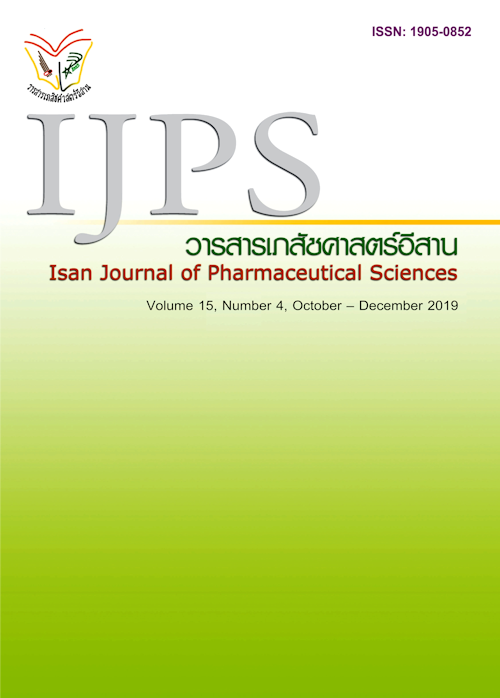Effect of drug use evaluation (DUE) program on appropriate use of Tigecycline
Main Article Content
Abstract
Inappropriate use of antimicrobials is the major cause of antimicrobial resistance and may increase the cost of treatment. Main strategy to minimize resistance and improve rational drug use for hospital is drug use evaluation (DUE). Also, the use of Tigecycline is increasing nowadays. Therefore, this study aimed to compare effectiveness of DUE towards the proper use of Tigecycline before and after DUE program implementation. Materials and methods: This retrospective cohort study was performed in inpatients received Tigecycline at Sunphasittiprasong hospital before DUE program implementation (1 November 2015 - 28 February 2016) and after DUE implementation (1 November 2016 - 28 February 2017). Data were collected by electronic medical chart review. The data were analyzed using descriptive statistics and Chi-square test. Results and discussion: There were 229 patients and 232 prescriptions, The number of prescriptions before and after DUE program implementation were 154 and 78, respectively. The appropriate indication was found in 68.7 and 73.3%, of prescriptions, respectively (p-value = 0.471) and the appropriate dose was found in 26.0 and 17.3% of prescriptions, respectively (p-value = 0.111). The decrease of inappropriate dose cause from the number of samples in both periods is different and DUE program in this hospital is clear about adjust dose of Tigecycline in liver condition. Conclusion: DUE program implementation tends to improve the appropriateness of Tigecycline use. The appropriate dosage was the most effective result from DUE program.
Article Details
In the case that some parts are used by others The author must Confirm that obtaining permission to use some of the original authors. And must attach evidence That the permission has been included
References
Ananwattanakit M, Tantawichien T, Puttilerpong C, Pengsuparp T. Effects of Pharmacist Participation in an Antimicrobial Stewardship Program on Appropriate Antibiotic Use. Thai Pharm Health Sci J. 2015;10(1):1-9.
Antibiogram 2016 (Jan-Jun) [Internet]. 2016 [cited 14 March 2017 ]. Available from: https://narst.dmsc.moph.go.th/antibiograms/2016/6/Jan-Jun2016-All.pdf.
Bassetti M, Nicolini L, Repetto E, Righi E, Del Bono V, and Viscoli C. Tigecycline use in serious nosocomial infections: a drug use evaluation. BMC Infect. Dis. 2010;10:287. doi: 10.1186/1471-2334-10-287
Boucher HW, Talbot GH, Bradley JS, Edwards JE, Gilbert D, Rice LB, et al. Bad bugs, no drugs: no ESKAPE! an update from the infectious diseases society of America. Clin. Infect. Dis. 2009; 48, 1–12.
Curcio D, Fernandez F, Cane A, Barcelona L, Stamboulian D. Indications of a new antibiotic in clinical practice: results of the tigecycline initial use registry. The Brazilian journal of infectious diseases. 2008;12(3):198-201.
De Rosa FG, Corcione S, Di Perri G, and Scaglione F. Re-defining tigecycline therapy. New Microbiol. 2015; 38, 121–136.
Eckmann C, Montravers P, Bassetti M, Bodmann KF, Heizmann WR, Sanchez Garcia M, et al. Efficacy of tigecycline for the treatment of complicated intra-abdominal infections in real-life clinical practice from five European observational studies. The Journal of antimicrobial chemotherapy. 2013;68 Suppl 2:ii25-35.
Horscht JJ, Zimmermann JB, Weigand MA, Bruckner T, Martin EO, Hoppe-Tichy T, et al. Comparative study of prescribing patterns of tigecycline for trial patients versus non-trial patients. In vivo (Athens, Greece). 2014;28(4):589-94.
Khon Kaen Hospital. Drug Use Evaluation. 2017 [cited 14 March 2017]. Available from: https://www.kkh.go.th/blog/blogs/file/2012_05_18_113414_jxtn4hp3iw.pdf.
Kittiwongsunthorn U. Control of drug procurement. 2016 [cited 14 March 2017]. Available from: https://dmsic.moph.go.th/dmsic/admin/files/userfiles/files/D1S2_Usanee.pdf.
Kollef MH, Sherman G, Ward S, Fraser VJ. Inadequate antimicrobial treatment of infections: a risk factor for hospital mortality among critically ill patients. Chest. 1999;115(2):462-74.
Luvira V, Overview of antibiotic resistance. Songkla Med J. 2006;24(5):453-9.
Moghnieh R A, Abdallah D I, Fawaz I A, et al. Prescription Patterns for Tigecycline in Severely Ill Patients for Non-FDA Approved Indications in a Developing Country: A Compromised Outcome. Front. Microbiol 2017;8:497.
Prakongsai N, Ruengdech K, Namsiripongphan W. Effectiveness of Drug Utilization Evaluation on Piperacillin-Tazobactam use at Prapokklao Hospital. The journal of Prapokklao Hospital Clinical Medical Education Center. 2013;1:6-23.
Peleg AY, Adams J, Paterson DL. Tigecycline Efflux as a Mechanism for Nonsusceptibility in Acinetobacter baumannii. Antimicrobial agents and chemotherapy. 2007;51(6):2065-9.
Phumart P, Phodha T, Thamlikitkul V, Riewpaiboon A, Prakongsai, Limwattananon S. Health and Economic Impacts of Antimicrobial Resistant Infections in Thailand: A Preliminary Study. Journal of Health Systems Research. 2012;6(3):352-60.
Dilokpattanamongkol P. Tigecycline: Focusing on current status of ventilation-associated Pneumonia. In: Wichai Santimaleeworakul CP, Niran Jangkong, Preecha Monthakantikul, editor. Handbook of Pharmacy: Antibiotics Smart Use. Bangkok. 2013; p. 238-53.
Principles of Antimicrobial Use 2006 [cited 21 March 2017]. Available from: https://www.ped.si.mahidol.ac.th/site_data/mykku_med/701000033/Principle%20use%20of%20ATB%20(379%20411).doc.
Professional Pharmacy Practice. 2017. [cited 23 March 2017]. Available from: https://www.thaihp.org/index.php?lang=th&option=contentpage&sub=29.
Seppälä H, Klaukka T, Vuopio-Varkila J, Muotiala A, Helenius H, Lager K, et al. The Effect of Changes in the Consumption of Macrolide Antibiotics on Erythromycin Resistance in Group A Streptococci in Finland. New England Journal of Medicine. 1997;337(7):441-6.
Supornpun S. Handbook of drug use evaluation by pharmacist 2017. [cited 14 Mar 2017]. Available from: https://si.joinmejoy.com/sites/default/files/files/document/PDF_final.pdf.
Swoboda S, Ober M, Hainer C, et al. Tigecycline for the treatment of patients with severe sepsis or septic shock: a drug use evaluation in a surgical intensive care unit. Journal of Antimicrobial Chemotherapy 2008;61(3):729-733.
The development of a service system for the appropriate drugs use 2017 [cited 14 March 2017]. Available from: https://bps.moph.go.th/new_bps/sites/default/files/4.6.1.pdf.
U.S. FDA Drug Safety Communication: Increased risk of death with Tygacil (tigecycline) compared to other antibiotics used to treat similar infections issued on September 1, 2010. 2010 [Internet]. [cited 14 March 2017]. Available from: https://www.fda.gov/drugs/drugsafety/ucm369580.htm.
Varghese ST, Surendran L, Antony C, et al. A Prospective Observational Study on Drug Utilisation Pattern of Restricted Antibiotics: Colistin, Teicoplanin and Tigecycline in a Tertiary Care Hospital. Indian Journal of Pharmacy Practice. 2017;10(3):216-221.


